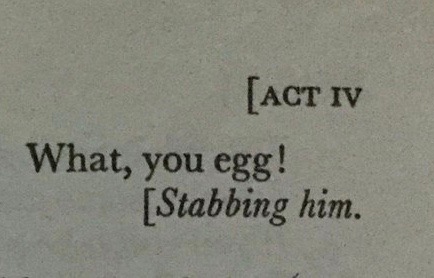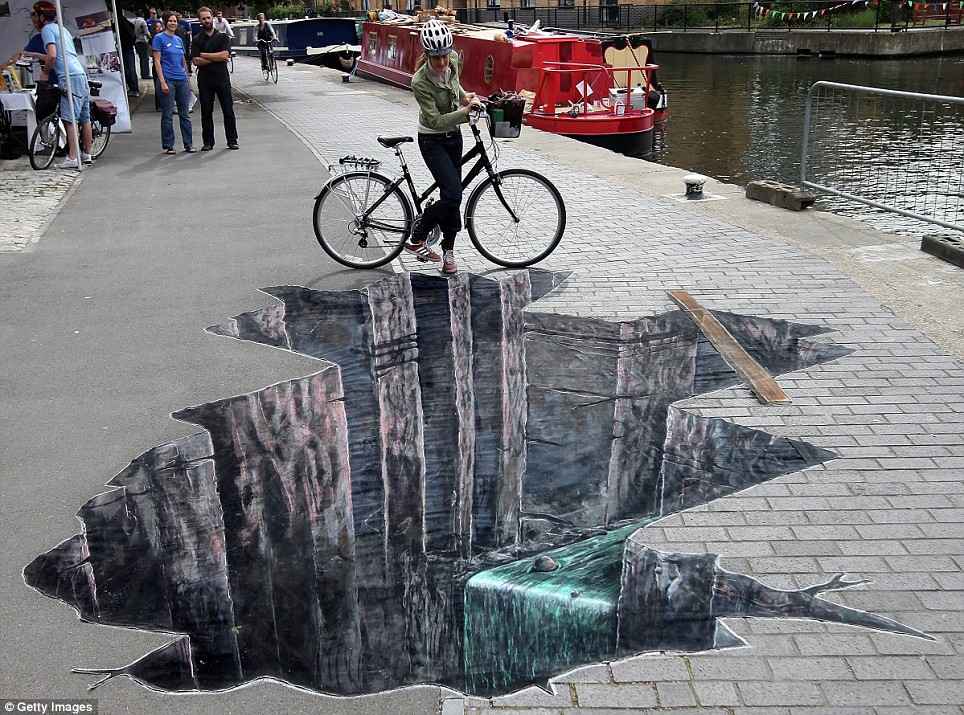"Would thou wert clean enough to spit upon."
~Timon of Athens
"Thine face is not worth sunburning."
~Henry V
"The rankest compound of villainous smell that ever offended nostril."
~The Merry Wives of Windsor
~Timon of Athens
"Thine face is not worth sunburning."
~Henry V
"The rankest compound of villainous smell that ever offended nostril."
~The Merry Wives of Windsor
"Thou damned and luxurious mountain goat."
~Henry V
"Thou hast no more brain than I have in mine elbows."
~Troilus and Cressida
"Thou whoreson zed; thou unnecessary letter!"
~King Lear
~Henry V
"Thou hast no more brain than I have in mine elbows."
~Troilus and Cressida
"Thou whoreson zed; thou unnecessary letter!"
~King Lear
"I do desire we may be better strangers."
~As You Like It
"His wit’s as thick as a Tewkesbury mustard."
~Henry IV, Part 2
"I am sick when I do look on thee."
~A Midsummer Night's Dream
~As You Like It
"His wit’s as thick as a Tewkesbury mustard."
~Henry IV, Part 2
"I am sick when I do look on thee."
~A Midsummer Night's Dream
"I’ll beat thee, but I would infect my hands."
~Timon of Athens
"More of your conversation would infect my brain."
~Coriolanus
"There’s no more faith in thee than in a stewed prune."
~Henry IV, Part 1
~Timon of Athens
"More of your conversation would infect my brain."
~Coriolanus
"There’s no more faith in thee than in a stewed prune."
~Henry IV, Part 1
"The tartness of his face sours ripe grapes."
~Coriolanus
"Thou leathern-jerkin, crystal-button, knot-pated, agatering, puke-stocking, caddis-garter, smooth-tongue, Spanish pouch!"
~Henry IV, Part 1
"Thy tongue outvenoms all the worms of Nile."
~Cymbeline
~Coriolanus
"Thou leathern-jerkin, crystal-button, knot-pated, agatering, puke-stocking, caddis-garter, smooth-tongue, Spanish pouch!"
~Henry IV, Part 1
"Thy tongue outvenoms all the worms of Nile."
~Cymbeline
"Thou art a Castilian King urinal!"
~The Merry Wives of Windsor
"You have such a February face, So full of frost, of storm, and cloudiness."
~Much Ado About Nothing
"This sanguine coward, this bed-presser, this horseback-breaker, this huge hill of flesh!"
~Henry IV, Part 1
~The Merry Wives of Windsor
"You have such a February face, So full of frost, of storm, and cloudiness."
~Much Ado About Nothing
"This sanguine coward, this bed-presser, this horseback-breaker, this huge hill of flesh!"
~Henry IV, Part 1
"I think thy horse will sooner con an oration than
thou learn a prayer without book."
~Troilus and Cressida
"Thou concludest like the sanctimonious pirate."
~Measure for Measure
"Let’s meet as little as we can."
~As You Like It
thou learn a prayer without book."
~Troilus and Cressida
"Thou concludest like the sanctimonious pirate."
~Measure for Measure
"Let’s meet as little as we can."
~As You Like It
"[Your] brain is as dry as the remainder biscuit after voyage."
~As You Like It
"Some report a sea-maid spawn’d him; some that he was begot between two stock-fishes. But it is certain that when he makes water his urine is congealed ice."
~Measure for Measure
~As You Like It
"Some report a sea-maid spawn’d him; some that he was begot between two stock-fishes. But it is certain that when he makes water his urine is congealed ice."
~Measure for Measure
"He has not so much brain as ear-wax."
~Troilus and Cressida
"Thou art a boil, a plague sore, an embossed carbuncle in my corrupted blood."
~King Lear
"Sell your face for five pence and ’tis dear."
~King John
~Troilus and Cressida
"Thou art a boil, a plague sore, an embossed carbuncle in my corrupted blood."
~King Lear
"Sell your face for five pence and ’tis dear."
~King John
"You, minion, are too saucy."
~The Two Gentleman of Verona
"I do wish thou were a dog, that I might love thee."
~Timon of Athens
"This kiss is as comfortless as frozen water to a starved snake."
~Titus Andronicus
~The Two Gentleman of Verona
"I do wish thou were a dog, that I might love thee."
~Timon of Athens
"This kiss is as comfortless as frozen water to a starved snake."
~Titus Andronicus
"Thou crusty batch of nature!"
~Troilus and Cressida
"Away thou rag, thou quantity, thou remnant."
~The Taming of the Shrew
"A weasel hath not such a deal of spleen as you are toss’d with."
~Henry IV, Part 1
~Troilus and Cressida
"Away thou rag, thou quantity, thou remnant."
~The Taming of the Shrew
"A weasel hath not such a deal of spleen as you are toss’d with."
~Henry IV, Part 1
"Drunkenness is his best virtue, for he will be swine drunk, and in his sleep he does little harm, save to his bedclothes about him."
~All's Well That Ends Well
"A rare parrot-teacher!"
~Much Ado About Nothing
"Thou lump of foul deformity!"
~Richard III
~All's Well That Ends Well
"A rare parrot-teacher!"
~Much Ado About Nothing
"Thou lump of foul deformity!"
~Richard III
"Would the fountain of your mind were clear again, that I might water an ass in it."
~Troilus and Cressida
"Not Hercules could have knocked out his brains, for he had none."
~Cymbeline
"Hang him, mechanical salt-butter rogue!"
~The Merry Wives of Windsor
~Troilus and Cressida
"Not Hercules could have knocked out his brains, for he had none."
~Cymbeline
"Hang him, mechanical salt-butter rogue!"
~The Merry Wives of Windsor
"If you had but looked big and spit at him, he'ld have run."
~The Winter's Tale
"Get thee glass eyes, and like a scurvy politician seem to see the things thou dost."
~King Lear
"Thou damned doorkeeper to every custrel that comes inquiring for his Tib!"
~Pericles
~The Winter's Tale
"Get thee glass eyes, and like a scurvy politician seem to see the things thou dost."
~King Lear
"Thou damned doorkeeper to every custrel that comes inquiring for his Tib!"
~Pericles
"Thou flea, thou nit, thou winter-cricket thou!"
~The Taming of the Shrew
"You scullion! You rampallian! You fustilarian! I’ll tickle your catastrophe!"
~Henry IV, Part 2
"Truly, thou are damned, like an ill-roasted egg, all on one side."
~As You Like It
~The Taming of the Shrew
"You scullion! You rampallian! You fustilarian! I’ll tickle your catastrophe!"
~Henry IV, Part 2
"Truly, thou are damned, like an ill-roasted egg, all on one side."
~As You Like It
"'Sblood, you starveling, you elf-skin, you dried neat's tongue, you bull's pizzle, you stock-fish! O for breath to utter what is like thee! you tailor's-yard, you sheath, you bowcase; you vile standing-tuck!"
~Henry IV, Part 1
~Henry IV, Part 1
"A knave; a rascal; an eater of broken meats; base, proud, shallow, beggarly, three-suited, hundred-pound, filthy, worsted-stocking knave; a lily-livered, action-taking knave, a whoreson, glass-gazing, super-serviceable finical rogue; one-trunk-inheriting slave...
...one that wouldst be a bawd, in way of good service, and art nothing but the composition of a knave, beggar, coward, pandar, and the son and heir of a mongrel: one whom I will beat into clamorous whining, if thou deniest the least syllable of thy addition."
~King Lear
~King Lear
• • •
Missing some Tweet in this thread? You can try to
force a refresh

 Read on Twitter
Read on Twitter























